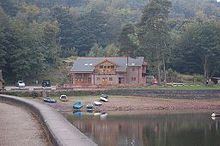Basin countries United Kingdom Area 66 ha | Length 3.219 km Year built 1799 Managing agency Canal & River Trust | |
 | ||
Surface area 664,000 square metres (164 acres) Water volume 2,950,000m³ (648 million gallons) Similar | ||
Rudyard lake rudyard near leek staffordshire
Rudyard Lake is a reservoir in Rudyard, Staffordshire. It was constructed in the late 18th century to feed the Caldon Canal. During the 19th century, it was a popular destination for daytrippers taking advantage of easy access using the newly constructed North Staffordshire Railway. The lake is still used for many water activities such as boating, canoeing, fishing and also for walks and recreational steam train trips.
Contents
- Rudyard lake rudyard near leek staffordshire
- Map of Rudyard Lake Leek UK
- Pike fishing on rudyard lake pt2
- HistoryEdit
- AttractionsEdit
- Top Gear episodeEdit
- References
Map of Rudyard Lake, Leek, UK
Pike fishing on rudyard lake pt2
HistoryEdit
The village of Rudyard was named after Ralph Rudyard, a local man reputed to have killed Richard III at the Battle of Bosworth Field. Rudyard Lake was constructed by the engineer John Rennie, for the Trent and Mersey Canal company in 1797–98 to feed the Caldon Canal.
On 26 June 1846 the North Staffordshire Railway successfully took over the canal company and lake as part of one of its acts of parliament that resulted in the formation of the North Staffordshire Railway. Having acquired the lake and the land around it the railway used the land down one side as the route for its Churnet Valley Line between Macclesfield and Uttoxeter. Two stations were built, one at Rudyard village (later renamed Rudyard Lake) and one at the north end of the lake called Rudyard Lake (later renamed Cliffe Park)
Because of the accessibility brought by the railway stations, daytrippers and tourists began visiting the lake. Visitors included John Lockwood Kipling and Alice Macdonald, the parents of Rudyard Kipling, who met there on a trip from Burslem. They liked the place so much they named their son after it. By the end of the 19th century up to 20,000 people visited the lake each day. Matthew Webb entertained crowds by demonstrating his swimming in the lake, and Carlos Trower (the African Blondin) performed a tightrope walk across the lake.
AttractionsEdit
The lake is home to Rudyard Lake Sailing Club and North Staffordshire Rowing Club. Fishing, walking, canoeing and boat trips are popular attractions. The lake has a visitor centre, toilets and an activity centre which can be hired for functions or conferences. An annual lake festival is held on a Sunday in August and a firework display takes place in November.
The Rudyard Lake Steam Railway runs narrow gauge steam trains that operate up the east side of the lake on many days throughout the year. It is possible to walk round the lake or walk part way and start/finish the journey by steam train.
Top Gear episodeEdit
The BBC's motoring show Top Gear held a challenge at the lake in 2006 to see which presenter had designed the best amphibious car. Richard Hammond's attempt sank while Jeremy Clarkson's attempt capsized with Richard on board at the end of the challenge. However, James May's Triumph Herald, complete with sail and mast, performed well, despite the almost total absence of wind, and he was able to drive it out of the water, thus winning the challenge.
